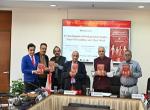Vivekananda International Foundation (VIF) organised a lecture by Dr. Shashibala, Dean at the Centre of Indology, Bhartiya Vidya Bhavan, New Delhi. The topic of the lecture was ‘Cave Temples in China’. Dr. Arvind Gupta, Director, VIF chaired the proceedings.
In her presentation, Dr. Shashibala strongly recommended that historical chronicles and travelogues of monks should be translated into English language in order to discard the Chinese narrative that ‘nothing came from India but it all developed in China’. These ancient chronicles have records of how Buddhism reached to China and how Chinese adopted and gradually developed its tentacles.
Dr. Shashibala, while explaining the importance of the caves told that these caves were a great source of historical evidences. The earliest reference to a cave is found in Rigveda followed by Atharvaveda and Shatapatha Brahmana. A Number of inscriptions and paintings found inside these caves give a clear understanding of socio-cultural, religious, economic and political conditions of a historical era. These caves were primarily carved out to be used for the meditation of the Buddhist monks. China has a number of cave complexes. These caves were highly regarded as a place of mediation and knowledge not only in ancient India but also in China. In China, caves were dug by the imperial ruler to provide a place of meditation to Buddhist monks. A number of philosophical texts are visualized inside these caves. Dunhuang caves are most significant because Amitayurdhyana Sutra and related philosophies are painted beautifully in these caves and first cave at Dunhunag was dug by an Indian monk. The style and technology used in the caves at Kucha, Kizil or Dunhuang evolved gradually in a sense of having greater Indian influence in its earlier phases to indigenisation in later phase, told Dr. Shashibala.
She has also emphasised on the Philosophical importance of Sculptures and paintings inside the caves in China especially depiction of flying angels holding garland and offering forms of dancing to the Divine. Dr. Shashibala told that this kind of depiction is so much a part of Indian religious offerings of Music and Naivedya (Offering to God). Yungang and Longmen caves in China has colossal and beautiful carving of sculptures of Buddha and his disciples. Kucha and Kumtura caves are significant because of their association with Buddhist Master Kumarajiva. Kucha was also a center of Buddhist learning. Caves in China are mainly situated along the ancient Silk Route through which Buddhism and Buddhist philosophies travelled from India to China and further to other places of the world. India is the spiritual leader of the world and Indian impact in China’s Buddhist art and architecture is a fine example of it, said Dr. Shashibala.
The talk generated good interest and there were many points of discussion.






Post new comment